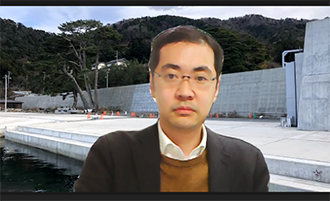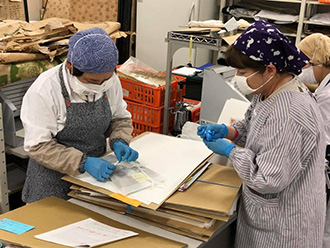2021.3.5
Lessons from the 2011 Great East Japan Earthquake: IRIDeS researchers talk about recovery and passing on disaster memories to future generations (2)

Dr. Daisuke Sato
D Sato: I co-authored Chapter 26, “Rescuing Historical Materials Owned by Private Families” with Dr. Atsushi Kawauchi. It is estimated that Japan has over two billion historical documents—with most of them being privately owned. Since the 1995 Great Hanshin-Awaji Earthquake, networks involving volunteers have been engaged in the rescue of historical materials affected by natural disasters in order to prevent the loss of valuable materials. Such activities were conducted in Miyagi Prefecture for the first time after the earthquakes in July 2003—in which I also participated.
Due to the Great East Japan Earthquake, irreplaceable human lives and hometowns were lost, as well as historical materials from many different places. On the other hand, in the 83 cases in which I was involved in, we were able to contact the owners of the materials and successfully rescue them; this was all thanks to the network that was built by the citizenry before the disaster. Furthermore, in the last decade, a total of 5,300 citizen volunteers have been involved in operations to prevent the deterioration of materials suffering water damage.

Citizens working on the preservation of
historical materials
(photo courtesy of Dr. Daisuke Sato)
These rescue and preservation activities have been popular with citizens who wished to do something helpful after the disaster. Furthermore, through these activities, some citizens became more interested in the content of historical documents and even learned how to read old Japanese writing. One person, in particular, even deciphered historical materials and released a publication on them. Activities used to preserve historical materials have a possibility to provide both psychological and social support for disaster victims—beyond just historical research and material rescue. That is a research topic of IRIDeS Visiting Professors, Dr. Kamiyama and Dr. Morris. Through these activities, disaster-affected people, who have once lost everything, can now reconstruct relationships with the past by reconnecting themselves with the history of their ancestors over a period of 200 to 300 years. In a sense, they are finding a way to avoid the historical discontinuation that was created by their own generation.
The disaster areas this time have been repeatedly experiencing major disasters. We also found that the historical documents make people more involved and become more aware of the history of past disasters and of the subsequent recovery from them—encouraging the recovery of the affected areas and people. In the past decade, I have realized that citizens, visitors, and experts that work together on a regular basis to engage in local history and practical activities have a potential to make communities more resilient to disasters.
Maly: It is interesting that historical documents can exert a spiritual influence. By the way, from an international perspective, things such as disaster folklore, disaster-related historical documents, and disaster storytelling all seem to have aspects unique to Japan. Are the methods that people used to pass down disaster stories in the past the same as they are today?
D Sato: There are historical documents that depict a disaster that had just occurred in the region; these documents also reviewed past disaster cases that happened there. The dates of the disasters that were recorded in those documents are accurate. So, I have been wondering about who passed down those disasters and how they had become memorialized in society. At that time, there were many situations where people gathered for their livelihood activities, such as for agriculture, forestry, and fisheries—as well as for other aspects of their daily life. Perhaps those topics on disasters were repeatedly brought up during those occasions. However, such scenes were not recorded and so we, therefore, have no knowledge about the actual situations. The people of the Edo period made a living by trading agricultural, forestry and fishery products. A disaster caused by natural hazards was always a risk factor, but it could also bring forth business opportunities. In any case, the information of disasters should have been directly related to their survival. I will keep thinking about the question about disaster storytellers that you have pointed out for my future study topic.
S Sato: Do you find it significant that your Preservation of Historical Materials Lab is in IRIDeS?
D Sato: I find it very meaningful to have an environment here where I can interact with scholars with different expertise on a daily basis and also introduce our activities to visitors. I have been greatly inspired during my time in IRIDeS; just like the topic on storytellers that was mentioned earlier. I would like to learn more about history even after the Edo period and continue to further develop my research.
Maruya: I suggest that, in the future, it would be worth taking a challenge to link your activities with IRIDeS research on the enhancement of hazard maps, in order to specify areas with higher disaster risks for photographing and digitizing historical materials as a priority in advance of disasters occurring.
D Sato: From 2003 to 2010, we conducted preventative activities; we were digitally photographing every single document with historical value. As a result, in the Great East Japan Earthquake, there are cases in which only photos survived, while the original documents were unfortunately lost. However, the problem is that there are too many historical documents in local areas to be properly digitized and organized. I see that it is also necessary to have a mind to appropriately share regional disaster risks with the owners of these historical materials in advance; this would be in order to protect the historical materials together with their owners and residents within the region.
